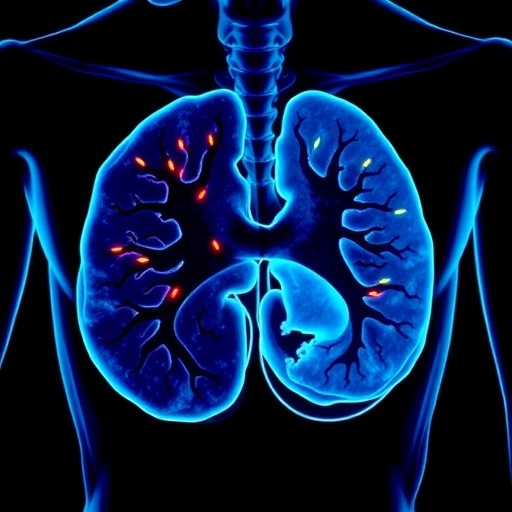In the continuous quest to enhance precision in cancer surgeries, a groundbreaking development has emerged from the University of British Columbia’s cutting-edge chemical research group. Scientists have engineered a novel dual-mode tracer that promises to revolutionize the detection and surgical management of prostate cancer. This innovative tracer melds the power of radioactive and fluorescent imaging into a single molecular entity, providing surgeons with unprecedented accuracy and multi-sensory guidance during complex operations.
This new tracer is uniquely labeled with Fluorine-18, a widely utilized isotope in Positron Emission Tomography (PET). Unlike conventional tracers that operate in a singular imaging mode, this agent combines PET imaging capabilities with bright fluorescence, thereby allowing not only high-resolution visualization through imaging technology but also real-time, visible guidance during surgery without the need for specialized visual equipment. This dual-functionality represents a paradigm shift toward seamless integration of diagnostic imaging and intraoperative navigation.
At the molecular level, the tracer is designed to target and bind prostate-specific membrane antigen (PSMA), a protein abundantly expressed on the surface of prostate cancer cells but minimally present in normal tissues. PSMA’s overexpression makes it an ideal target for selective delivery and accumulation of the tracer within malignant tissues. By exploiting this biomarker, the tracer achieves both high tumor uptake for PET scans and intense optical brightness in fluorescent mode, streamlining tumor localization efforts.
.adsslot_NUlhFqgf7n{ width:728px !important; height:90px !important; }
@media (max-width:1199px) { .adsslot_NUlhFqgf7n{ width:468px !important; height:60px !important; } }
@media (max-width:767px) { .adsslot_NUlhFqgf7n{ width:320px !important; height:50px !important; } }
ADVERTISEMENT
Dr. David M. Perrin, senior author and chemist at UBC, highlights the importance of integrating precision medicine with surgical oncology. According to Dr. Perrin, this tracer offers more than just visual cues; it equips surgeons with auditory feedback through hand-held Geiger counters that detect localized radioactivity in cancerous regions. This multi-sensory approach enables identification of cancerous tissues that might elude direct visualization, including metastatic lymph nodes or areas of invasion into adjacent organs such as the bowel.
Preclinical evaluations of the tracer have been performed using murine models implanted with human prostate tumors, demonstrating promising specificity and efficiency in tumor targeting. These studies underscore the potential of the agent to enhance surgical planning and execution, reducing the likelihood of residual cancer post-resection. The ability to combine PET and fluorescence in a one-step process addresses a significant gap in current clinical approaches, minimizing patient discomfort associated with multiple injections and simplifying operative workflows.
Radiochemist Jerome Lozada, the lead experimentalist on the project, emphasizes the translatability of this tracer’s technology. The incorporation of 18F-organotrifluoroborates conjugated to fluorescein not only confers high fluorescent brightness but also ensures compatibility with existing PET infrastructure in a range of healthcare environments. By broadening access to dual-mode tracers, this methodology holds promise for smaller and resource-limited hospitals, democratizing advanced prostate cancer care.
The clinical impetus for this innovation is underscored by epidemiological data from the Canadian Cancer Society, which reveals that approximately one in eight Canadian men will be diagnosed with prostate cancer in their lifetime, with one in thirty succumbing to the disease. Surgical treatment often requires a nuanced balance—achieving maximal tumor resection while preserving vital structures such as nerves, seminal vesicles, bowel, and bladder, particularly in locally advanced disease stages. This tracer could be pivotal in tipping the scales toward safer, more effective surgeries.
Support from leading urologists reinforces the potential clinical impact of dual-mode tracers. Dr. Larry Goldenberg from the Vancouver Prostate Centre notes that these agents could substantially reduce the need for extensive lymph node dissections, thereby minimizing collateral damage and improving surgical margins during radical prostatectomies. Enhanced local disease control, coupled with theoretical improvements in oncologic outcomes, positions this dual-mode imaging as a transformative advancement in prostate cancer surgery.
Further endorsement comes from Dr. Philip F. Cohen, division head of nuclear medicine at Lions Gate Hospital, who compares the new tracer favorably with existing breast cancer techniques that utilize separate injections of radioactive tracers and dyes. The single-injection dual tracer consolidates these functions, potentially reducing procedural complexity and enhancing intraoperative detection fidelity. Such convergence streamlines surgical protocols and may reduce operative times.
Looking ahead, the research team is poised to initiate Good Manufacturing Practices (GMP) evaluations, toxicity assessments, and extensive validation studies to transition this promising tracer from preclinical success to clinical application. The dual-mode tracer platform also harbors potential beyond prostate cancer, with researchers considering adaptations for malignancies such as laryngeal and ovarian cancers, further expanding its therapeutic scope.
This initiative received essential funding from the Canadian Institutes of Health Research, which supports innovative biomedical breakthroughs aimed at improving patient outcomes. The collaboration between chemists, oncologists, and radiochemists illustrates the interdisciplinary nature of modern cancer research, blending chemistry, molecular biology, and clinical science into a cohesive drive toward precision oncology.
By harnessing the synergies of radioactive and fluorescent modalities within a singular molecular agent, this tracer embodies a next-generation tool that could redefine surgical oncology paradigms. Its development not only advances the physical act of tumor removal but also propels the integration of diagnostics, imaging, and therapy into a seamless continuum of cancer care.
Subject of Research: Development and preclinical evaluation of dual-mode fluorescent and PET tracers targeting PSMA for enhanced imaging and surgical guidance in prostate cancer.
Article Title: Synthesis and Preclinical Evaluation of Dual-Mode Fluorescent F-PET Tracers Targeting PSMA
Web References:
– DOI: http://dx.doi.org/10.1021/acs.jmedchem.5c01480
Image Credits: University of British Columbia, Perrin Lab.
Keywords: Prostate cancer, Diseases and disorders, Cancer treatments, Medical imaging, Tomography, Chemical biology, Chemical compounds
Tags: cancer surgery advancementsdual-mode imaging tracersfluorescence in cancer surgeryFluorine-18 PET imaginginnovative surgical technologiesintraoperative navigation systemsmolecular imaging developmentsprecision medicine in oncologyprostate cancer detectionprostate-specific membrane antigen targetingreal-time surgical guidanceUniversity of British Columbia research





